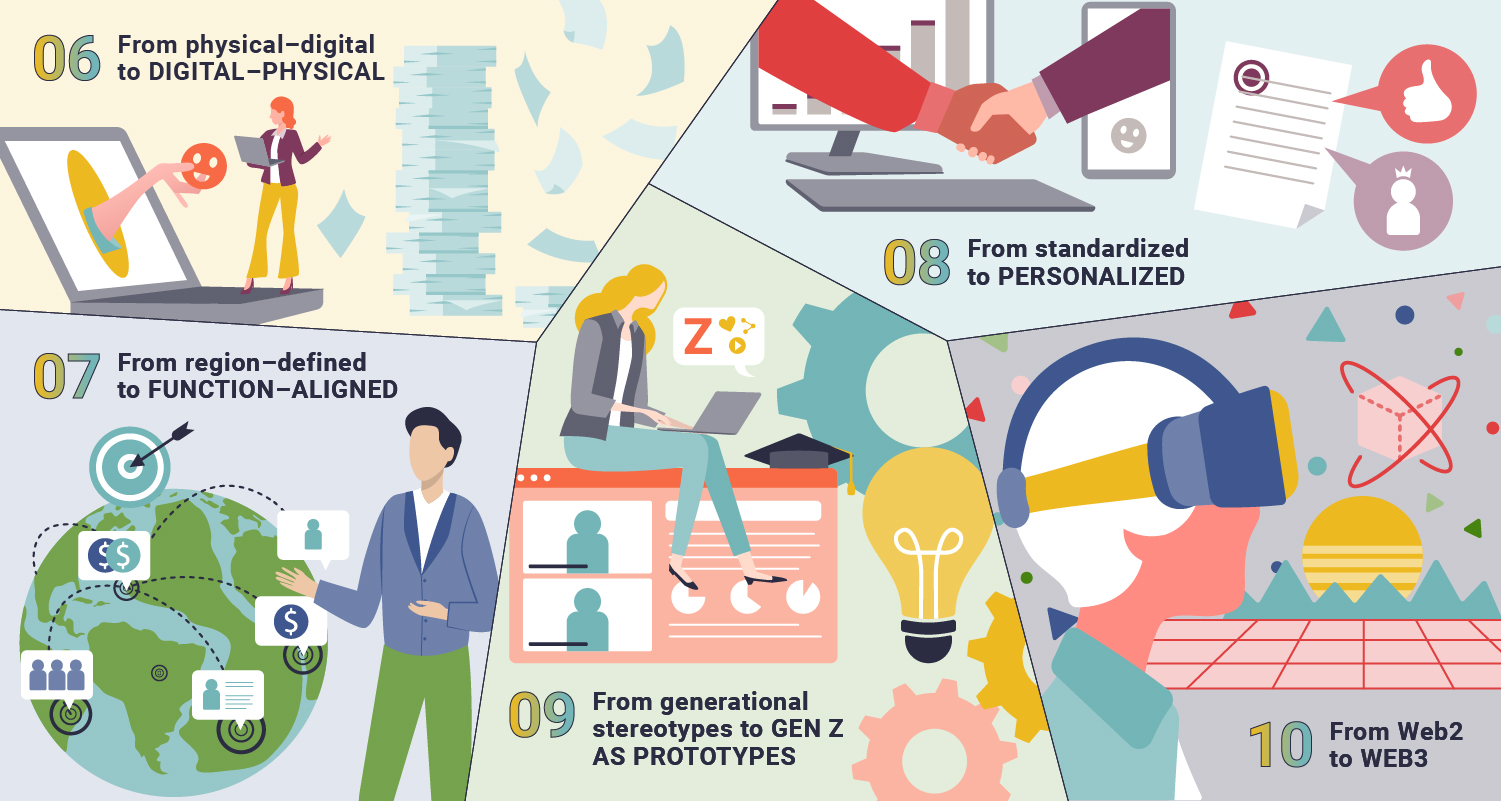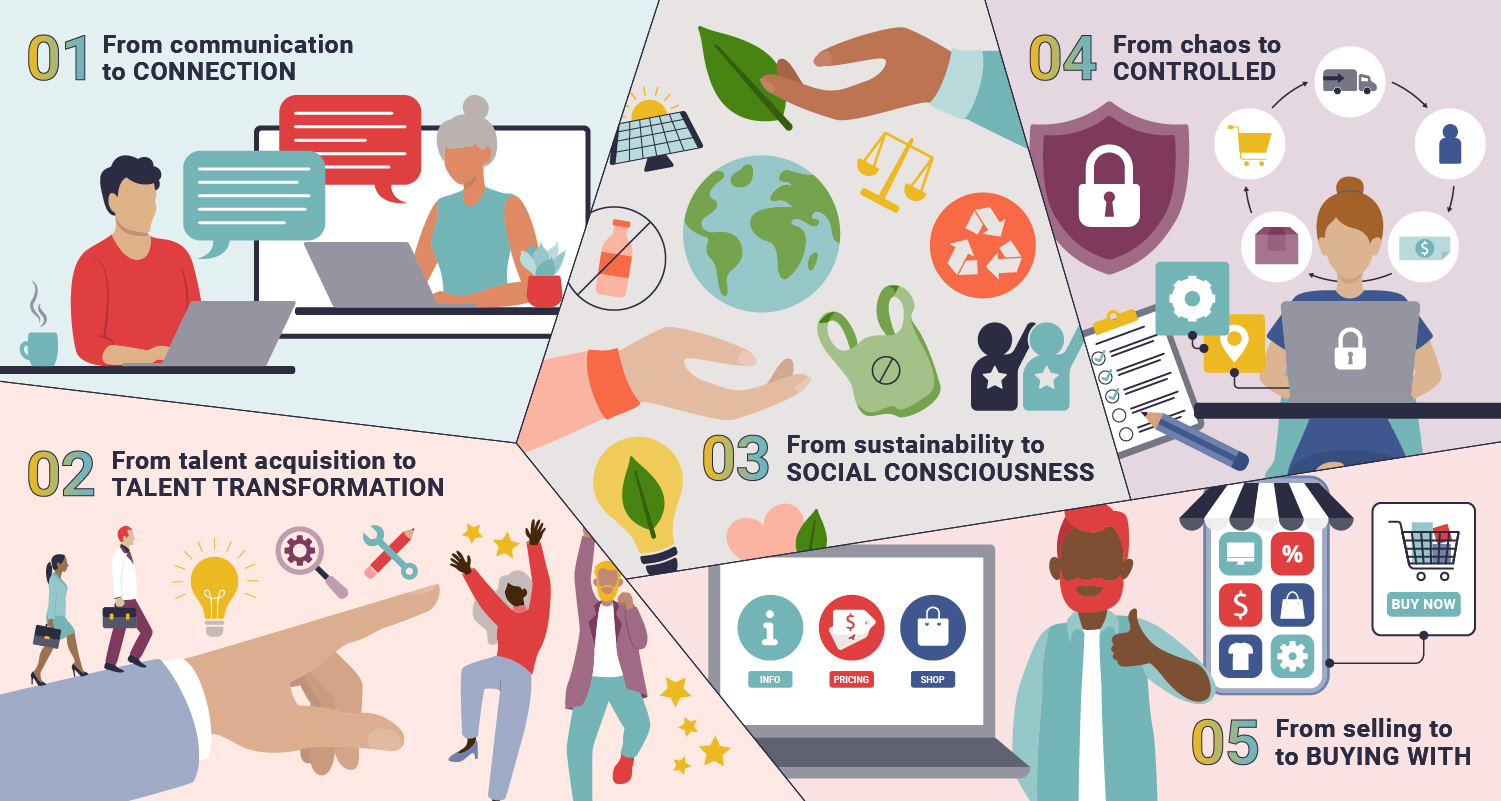
“I have more respect for the fellow with a single idea who gets there than for the fellow with a thousand ideas who does nothing.” —Thomas Edison
Our job is to help you look up from the urgent busy-ness and take note of the vital actions to move your business forward.
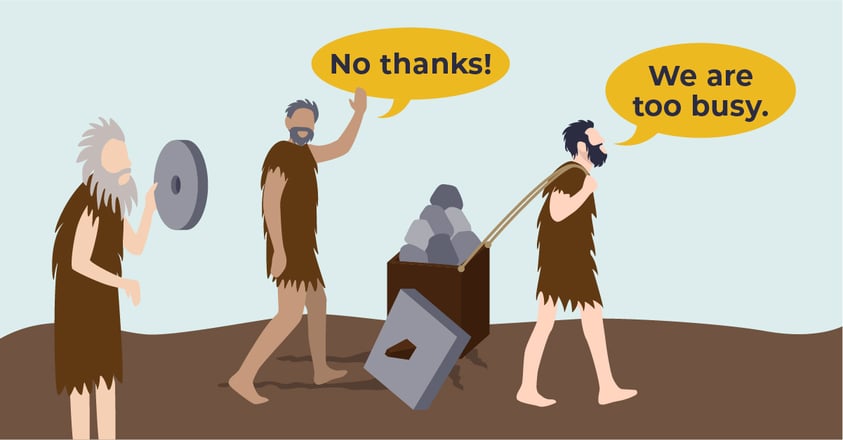
Each year, ThinkLab tackles the new year by looking at the 10 biggest shifts affecting the future of the contract
interiors industry. Whether you are a design firm, manufacturer, distributor, or anything in between, this annual
exploration summarizes leading indicators of where our collective world is headed, and how we can prepare our
organizations to stay competitive for the future. Think of this as a preview of a tangible, practical future that is
within reach or, in some cases, already here.
In part one, we cover the five shifts you should already be focused on to ensure your business
doesn’t fall behind.
01. A shift from communication to connection
Ironically, the interiors industry is struggling with the very challenges we are advising our clients on today. We, as
an industry, are in our own awkward adolescence, undergoing a crucial transition. This means reframing our own
workflows from in-person connection, mentorship by observation, and analog ways of doing business into
connected cultures, with workflows optimized for true connection across multiple fronts (in-office, hybrid, and
remote). As with the rest of the world, ThinkLab industry-specific data shows that individual workers still have a
greater preference for hybrid work, while companies have a greater preference for more time spent in the office.
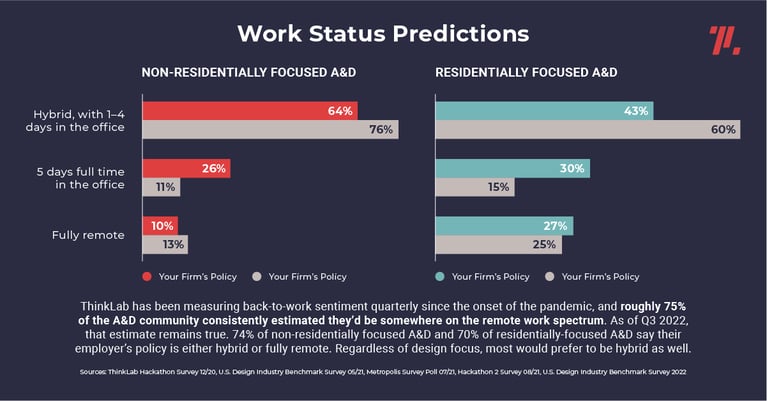
Here’s the bottom line: Communication is something that’s done transactionally, while connection is felt.
Connecting takes a lot more intentionality if it’s done digitally. We need to be careful as humans that we don’t
naturally choose convenience over connection. (And also guard our teams from disconnection.)
Whether you’re a designer trying to communicate with your clients while navigating this new normal, or a leader
trying to create the “next normal” for your company, here’s one action you can take today: Learn how others
within the design ecosystem are navigating their client’s new normal in this podcast.
02. A shift from talent acquisition to talent transformation
Our industry, like many others, is finding new ways to retain existing talent, embracing DE&I initiatives to attract
new talent, and rebuilding teams post – “the Great Resignation” — especially as the skill sets needed for success in
some sectors of our industry are evolving. From 2019–2021, the top 100 Interior Design Giants of Design reduced
their staff by 48 percent, and now are trying to rebuild in one of the most competitive job markets we’ve ever
seen.
As the industry evolves, many manufacturers and distributors are in need of new types of industry talent, and the
process of onboarding to the nuances of this industry is often long and unsuccessful. Recruiting the right people to
our industry and retaining our star players has arguably never been more important.

Here’s the bottom line: The 2020–2021 period has been called the Great Reevaluation. If you’re not helping your
best asset — your people — up their own game, you’re missing the boat ( . . . or missing people in your boat).
So, what’s one action you can take today? Check out the industry’s first-ever CEU podcast, especially our episode on how to design for equity and belonging (and get credit while you do so). Or, if you’re not a designer, check out a variety of ThinkLab courses designed for the product side of our industry, and upskill yourself for the future. (More courses coming from ThinkLab in 2023.)
03. A shift from “just sustainability” to social consciousness
According to Metropolis, the interior design industry will have influence over one-tenth of the world’s carbon emissions by 2050. Add to this that the average designer has 26 times the specification power as the average American consumer has buying power. And that number can be as much as 111 times more when you get into the Interior Design Giants of Design. Simply put, our decisions matter. And research shows Gen Z is influencing all generations to make sustainability-first decisions, even if cost is not equal.
But today, “sustainability” goes beyond just recycled or recyclable product. According to recent NielsenIQ insights, the socially conscious shoppers of 2022 want to “choose products and support brands that are good for them, good for their neighbors, and good for the planet.” This social activism must be true to the brand — not a marketing ploy.
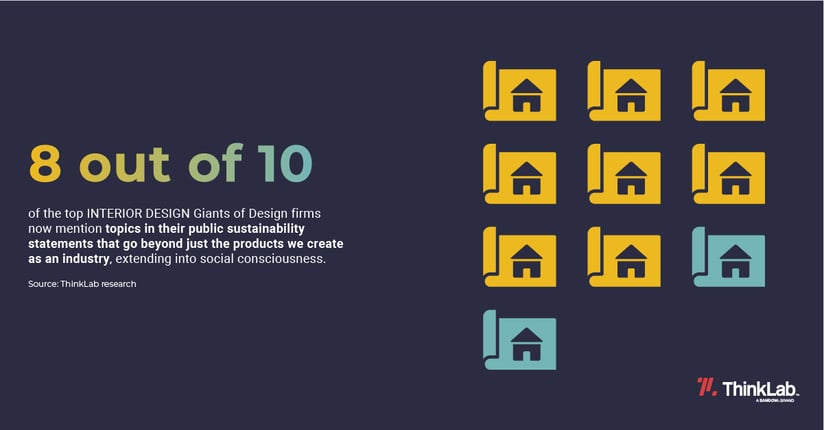
Here’s the bottom line: The sustainability conversation today is MUCH broader than before. Today, your brand is either authentically practicing what it preaches, or it’s seen as detracting from the cause. There’s no longer a neutral option.
So, what’s one action you can take today? Check out this podcast that explores how to help us as an industry, and even our clients, make better decisions when it comes to the environment.
04. A shift from chaos to controlled
What does ThinkLab hear as the top issue on business leaders’ minds today? Supply chain woes. This notable Business of Homes podcast episode shares how that is (thankfully) becoming a fading concern as we approach 2023, at least for the residential side. However, as of the end of 2022, ThinkLab research shows that it is still topping the list for commercial clients, designers, and (especially) distributors.
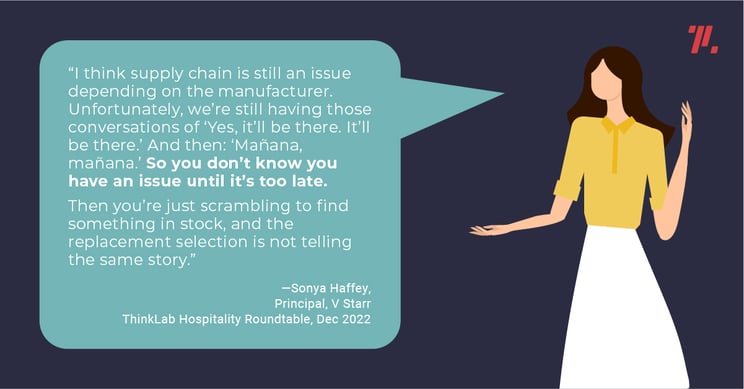

Here’s the bottom line: Residual supply-chain challenges are pushing leading organizations to shift their perspective to what’s in their control. From adopting new technologies to localizing their supply chains, tomorrow’s leaders are leaving less to chance and are managing their clients’ expectations with more transparency than ever.
Now, if you’re frustrated at the lack of visibility, please know it’s not that your product vendors don’t want to tell you that information. It’s that, historically, our supply chain has been so complex, most lack the visibility to share. According to McKinsey research, last year only 2 percent of respondents said they had complete visibility into their supply chains. This year, that fraction rose to 17 percent. And while, unfortunately, we are still a long way away from a “Domino’s pizza tracker” tool for our industry, leading companies are taking control and localizing their supply chain (a win for both the control freaks and the environment). And those that are getting ahead are beginning to share that transparency with their clients. Just check out this inventory checker from Mannington Commercial, complete with recommended alternatives. We also recently stumbled across this one from J&J flooring or this one from Koroseal.
So, what’s one action you can take today? Check out this Mpowered podcast episode where ThinkLab answers a listener-submitted question about how to explain to their clients why these issues are still happening. (And feel free to share this episode if it helps you!)
05. A shift from “selling to” to “buying with”
According to broad McKinsey research, more than 90 percent of B2B companies feel their current sales model is more effective than it was pre-pandemic. In contrast, a ThinkLab survey of in-industry leaders found that only 56 percent of companies surveyed feel their model today is more successful. This means that most companies (and reps) are still struggling to navigate changes accelerated by the past couple of years.
McKinsey research suggests that these changes are here to stay and recommend companies follow a best practice called “the rule of thirds.”
This means the ideal client journey is now:
-
1/3 face-to-face
-
1/3 digital and synchronous (Zoom, phone, etc.)
-
1/3 asynchronous self-serve
Ironically, ThinkLab data suggests that, in our industry, the average rep has gone from spending 80 percent of their time face-to-face before the pandemic to less than half of their time today. This puts ThinkLab in-industry data squarely in line with McKinsey data. We’ve found that roughly 30 percent to 35 percent (or one-third) of the average rep’s time is now face-to-face.

Here’s the bottom line: If you haven’t mastered the basics in this increasingly phygital (physical + digital) world, you’re already playing from behind. (You just may not quite feel it yet.) Leading brands are proactively piloting technologies to simplify the buyer’s journey and leading with empathy to help their human capital evolve for a new era.
So, what’s one action you can take today? Check out this podcast, where we interview one of the researchers behind that great McKinsey research and translate it to what this means for our beloved industry.
Get the Research
We're tracking these shifts and sharing leading indicators of where our collective world is headed, and how we can prepare our organizations to stay competitive for the future. Now that you have the foundations, here are five shifts you can focus on to get (or stay) ahead.
Want to dive even deeper into each of these trends with us? Our new complimentary digital course dives much deeper into each trend with even more detailed evidence, shares statistics to help you create internal buy-in, translates implications to our industry (and your business), and inspires with motivating stories from companies we’ve identified as ahead of the curve.
Not sure where to start? Don’t worry, each shift in this course ends with key action items for you and your team to tackle to get (or stay) ahead. Enroll in 10 Tectonic Shifts for the Design Industry.
Amanda Schneider is President of ThinkLab, the research division of SANDOW. At ThinkLab, we combine SANDOW Media’s incredible reach to the architecture and design community through brands like Interior Design Media, Metropolis, Luxe, and Material Bank with proven market research techniques to uncover relevant trends and opportunities for the design industry. Join in to explore what’s next at thinklab.design/join-in.

